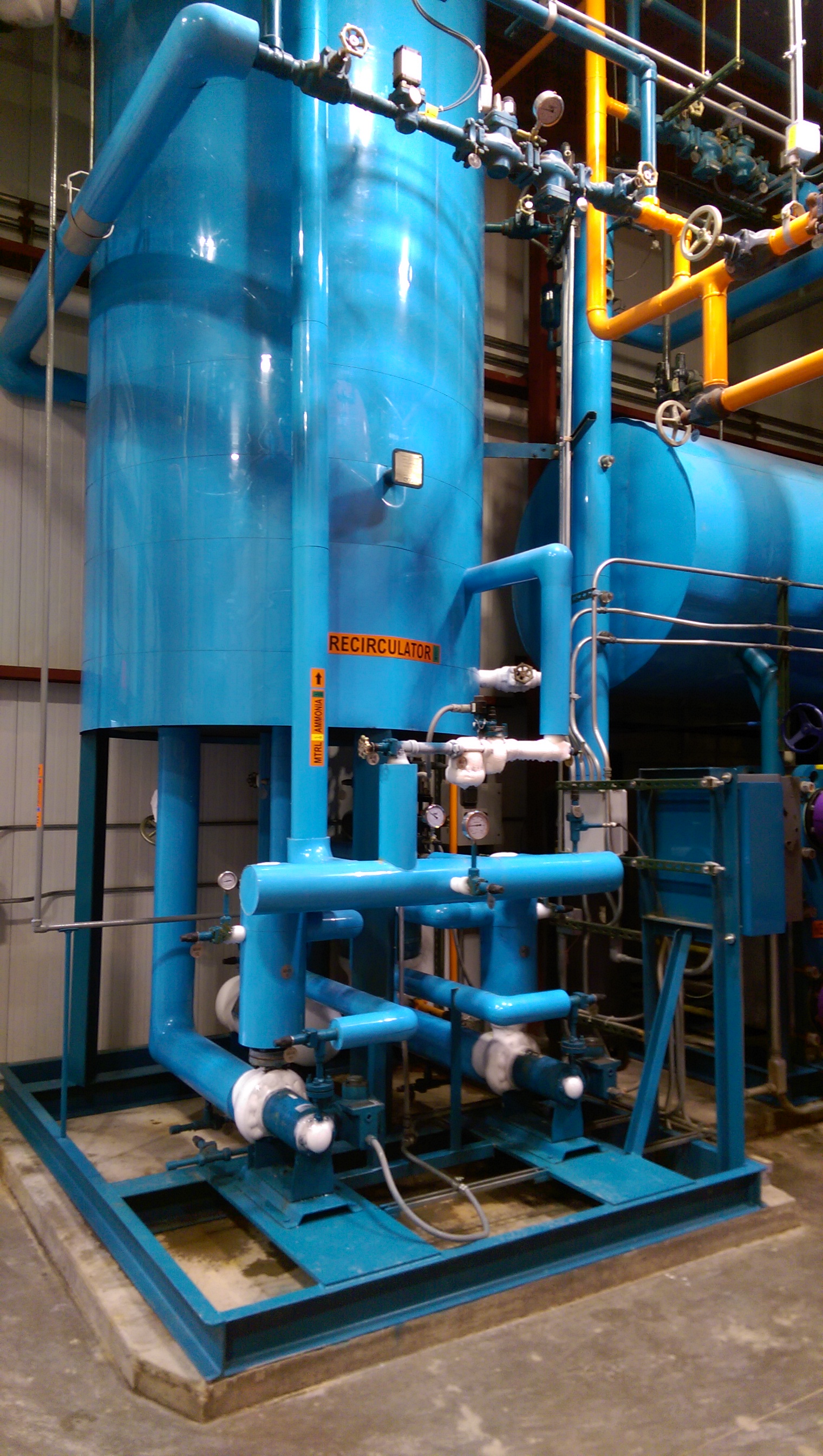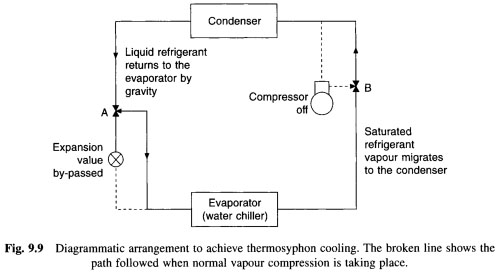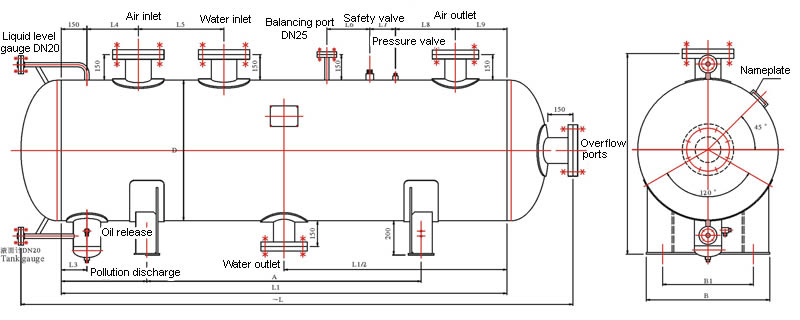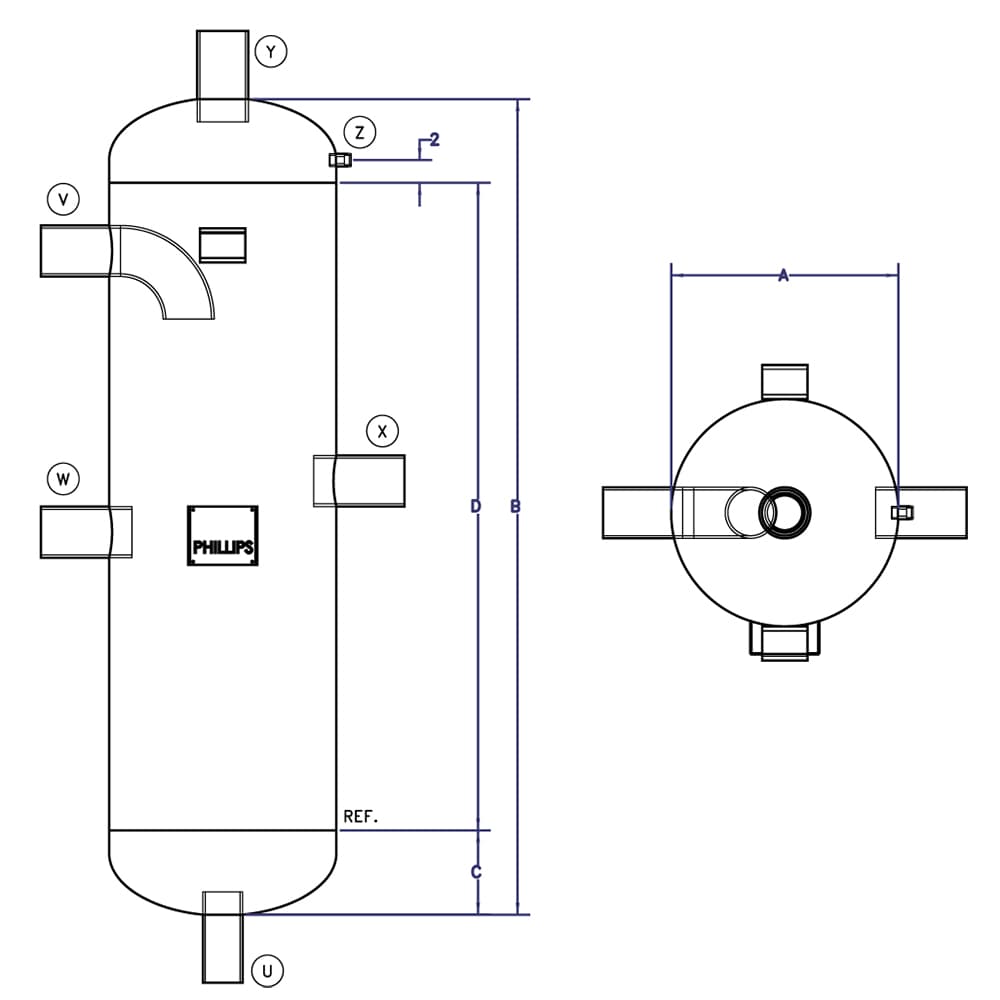The fouling resistance for condensing steam can be taken as 000005 -. The recommended pressure gradients11 for this pipe are 226 Pam 01 psi per 100 ft for ammonia and 113 Pam 05 psi per 100 ft for R-22. Ammonia thermosyphon design.
Ammonia Thermosyphon Design, These oil coolers are typically ASME pressure vessels and bear an ASME stamp. 250 psi standard design pressure 300 psi on 24 inch and smaller Post weld heat treatment. Higher design pressures for non-ammonia applications. 1 Tube length inside and outside diameter and pitch.
 Industrial Refrigeration Basics The Engineering Mindset From theengineeringmindset.com
Industrial Refrigeration Basics The Engineering Mindset From theengineeringmindset.com
Manufacturers design thermosiphons for electronics using the same premise as solar and automotive thermosiphons. Design Parameters Design pressure. Thermosyphon piping loop is exactly equal to the pressure differential supplied by the difference in fluid densities and the height of the vertical legs in the piping loop. The properly designed thermosyphon receiver will guarantee the preferential flow of liquid refrigerant to the oil cooler before satisfying other system requirements for liquid.
F 1800 Leaving fluid temp.
Read another article:
Industrial refrigeration systems primarily use ammonia as a refrigerant. It has been a common design for the oil to be circulated through the shell side of a shell and tube heat exchanger while ammonia is circulated through the tube side. 250 psi standard design pressure 300 psi on 24 inch and smaller Post weld heat treatment. Consider that the normal inlet oil temperature is 175 to 180 degrees F 607- to 644-psi saturated ammonia NH3 pressure and outlet oil temperature is 120 to 140 degrees 300- to 394-psi saturated NH3 pressure. Vertical high pressure thermosyphon receivers serve as both the system high pressure receiver and as a thermosphon.
 Source: ddref.com
Source: ddref.com
As a result the fouling resistance may be a major part of the total resistance and is thus a critical factor in the design. Screw compressors with thermosyphon oil cooling will be used. 3 Inlet piping length diameter and details of fittings. However given their use in high-power industrial applications these designs are often proprietary. Industrial Refrigeration Systems Screw Compressors Piping Design Ammonia And Co2 Refrigerant And Cold Storage Construction Services For Businesses Throughout The United States Discovery Designs Refrigeration Llc Mukwonago Wisconsin 53149.
 Source: esigroupusa.com
Source: esigroupusa.com
The baseline specifications and parameters chosen are shown in Table 1. The properly designed thermosyphon receiver will guarantee the preferential flow of liquid refrigerant to the oil cooler before satisfying other system requirements for liquid. Freechiller annualised Coefficient of Performance COSPs ranges between 10 to 15 depending on design temperature chiller configuration and method of heat rejection. 250 psi standard design pressure 300 psi on 24 inch and smaller Post weld heat treatment. How To Build An Ammonia Room Esi Group Usa.
 Source: nhtres.com
Source: nhtres.com
Pressure a conceptual cycle analysis and preliminary design of a refrigeration system. These oil coolers are typically ASME pressure vessels and bear an ASME stamp. This training video describes in more detail the process scheme of an ammonia refrigeration unit with a system of measuring instruments for process. Design Parameters Design pressure. Types Of Nh3 Systems How They Work.
 Source: sciencedirect.com
Source: sciencedirect.com
You typically design an ammonia thermosiphon chiller to operate around 3 or 4 to 1 circulation ratio. F 950 Leaving pressure psig 1818 Circulation rate 2 Surge drum height adder ft 17 Fluid type Bitzer compressor oil Fluid mass flow rate lbmin 2511 Entering fluid temp. As ambient temperatures fall below the return water temperature free cooling is available by thermosyphon circulation of refrigerant around the chiller without running compressors. When designing a thermosyphon oil cooling system one usually begins with the design oil cooler heat rejection and an assumed refrigerant overfeed rate say 41. Thermosyphon Assisted Cooling System For Refrigeration Applications Sciencedirect.
 Source: sciencedirect.com
Source: sciencedirect.com
Designers of thermosyphon systems strive for a circulation ratio of 31 for ammonia and 21 for R-22 where the circulation ratio means the rate supplied to the heat exchanger divided by the rate evaporated. Ammonia Data Book B-1 May 2008 Appendix B Ammonia Refrigeration Application Data General. Our deep knowledge of the principles of refrigeration systems allows us to create custom. Oliveira et al 2016. Thermosyphons An Overview Sciencedirect Topics.
 Source: creativesafetysupply.com
Source: creativesafetysupply.com
Freechiller annualised Coefficient of Performance COSPs ranges between 10 to 15 depending on design temperature chiller configuration and method of heat rejection. Design Conditions Side A - Evaporating Side B - Liquid Refrigerant R-22 Ref. You typically design an ammonia thermosiphon chiller to operate around 3 or 4 to 1 circulation ratio. 20MPa Water pressure test. Ammonia Pipe Marking Label Thermosyphon Return.
 Source: ref-wiki.com
Source: ref-wiki.com
4 Outlet piping diameter length layout and details of fittings. The recommended pressure gradients11 for this pipe are 226 Pam 01 psi per 100 ft for ammonia and 113 Pam 05 psi per 100 ft for R-22. These oil coolers are typically ASME pressure vessels and bear an ASME stamp. The properly designed thermosyphon receiver will guarantee the preferential flow of liquid refrigerant to the oil cooler before satisfying other system requirements for liquid. Thermosyphon Cooling.
 Source: freeenergyplanet.biz
Source: freeenergyplanet.biz
When designing a thermosyphon oil cooling system one usually begins with the design oil cooler heat rejection and an assumed refrigerant overfeed rate say 41. Industrial refrigeration systems primarily use ammonia as a refrigerant. The thermosiphon is like a flooded system flow rate is typically 31 up to 101 or more but generally I stick to 51. It has been a common design for the oil to be circulated through the shell side of a shell and tube heat exchanger while ammonia is circulated through the tube side. How Do Thermosyphon Systems Work Solar Water Heater.
 Source: youtube.com
Source: youtube.com
The fouling resistance for condensing steam can be taken as 000005 -. As a result the fouling resistance may be a major part of the total resistance and is thus a critical factor in the design. Design Specifications and Parameters for Vectra Desktop CPU Pentium 4 1400 MHz. Designers of thermosyphon systems strive for a circulation ratio of 31 for ammonia and 21 for R-22 where the circulation ratio means the rate supplied to the heat exchanger divided by the rate evaporated. Ammonia Refrigeration Ammonia Evaporator Animation Youtube.

Industrial refrigeration systems primarily use ammonia as a refrigerant. Design Conditions Side A - Evaporating Side B - Liquid Refrigerant R-22 Ref. Our deep knowledge of the principles of refrigeration systems allows us to create custom. 3 Inlet piping length diameter and details of fittings. 2.
 Source: chineserefrigeration.com
Source: chineserefrigeration.com
Thermosyphon oil coolers for compressors have been designed in several ways. Mass flow lbmin 820 Target evaporator temp. Thermosyphon Receivers are secondary vessels placed between the high pressure receiver and the expansion device to store both system liquid and liquid that is used to cool the compressor lubricant. F 950 Leaving pressure psig 1818 Circulation rate 2 Surge drum height adder ft 17 Fluid type Bitzer compressor oil Fluid mass flow rate lbmin 2511 Entering fluid temp. Thermosiphon Receiver Liquid Ammonia Reservoir Wanxiang Liquid Storing Container Maker.

Industrial refrigeration systems primarily use ammonia as a refrigerant. Design Parameters Design pressure. Manufacturers design thermosiphons for electronics using the same premise as solar and automotive thermosiphons. The first step in designing the thermosyphon is to verify the cooling requirements and the available space for integrating the device with the CPU. 2.
 Source: youtube.com
Source: youtube.com
Oliveira et al 2016. The thermosiphon is like a flooded system flow rate is typically 31 up to 101 or more but generally I stick to 51. Features When a refrigerating compressor unit is used in the refrigeration system a thermosiphon liquid receiver is required to separate the refrigerating medium from return-gas in oil condenser. The thermosyphon oil cooler on a screw compressor can and will generate the greatest system vapor pressure. Ammonia Refrigeration Ammonia Evaporator Animation Youtube.
 Source: simmakers.com
Source: simmakers.com
Design Specifications and Parameters for Vectra Desktop CPU Pentium 4 1400 MHz. Industrial refrigeration systems primarily use ammonia as a refrigerant. It has been a common design for the oil to be circulated through the shell side of a shell and tube heat exchanger while ammonia is circulated through the tube side. Our deep knowledge of the principles of refrigeration systems allows us to create custom. Thermosyphon Technology For Ground Freezing Simmakers Ltd Company.
 Source: haphillips.com
Source: haphillips.com
Ammonia is 100 natural does not harm the environment and is the most efficient refrigerant available. F 950 Leaving pressure psig 1818 Circulation rate 2 Surge drum height adder ft 17 Fluid type Bitzer compressor oil Fluid mass flow rate lbmin 2511 Entering fluid temp. 62 Fouling Resistance Thermosyphon boilers are designed to achieve a high boiling coefficient. 3 Inlet piping length diameter and details of fittings. Thermosyphon Receivers Phillips Refrigeration.







